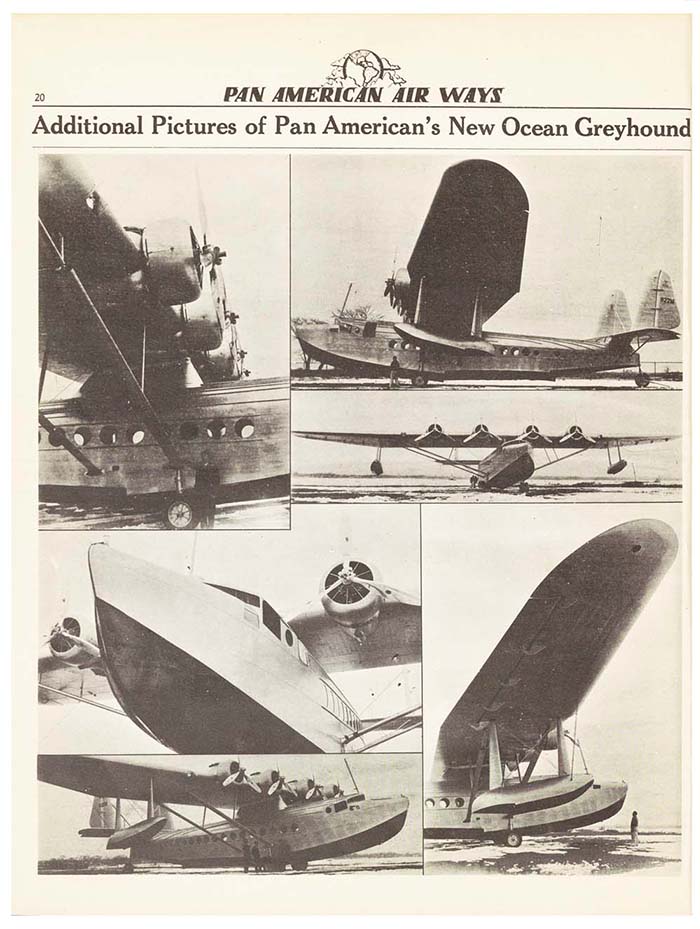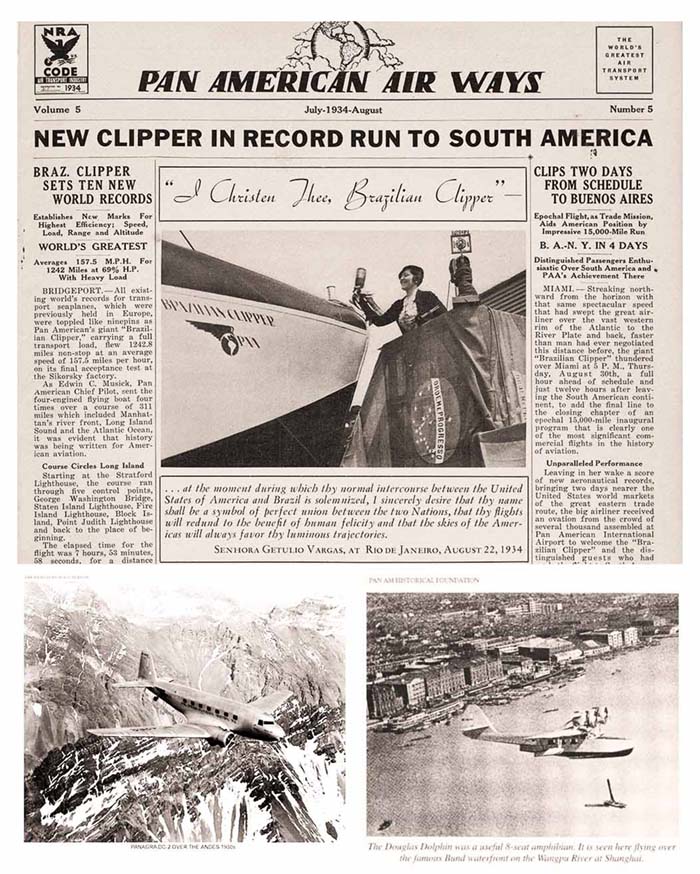90 YEARS AGO
Pan Am in 1934
Unique stories of Pan American Airways operations -- Its people, aircraft and far-flung destinations. Posted month-by-month
Jump to

JANUARY 1934
1. “Flying High into '34”
"Pan American's New Ocean Greyhound," the Sikorsky S-42 ("Pan American Air Ways, " Jan. 1934).
Pan American Airways System entered the new year, 1934, having set new performance records for itself the prior year in all but one of the major metrics it shared.
As stated in the January issue of the company newsletter, Pan American Air Ways,
“The following is the operating record of the Pan American Airways System to January 1, 1934.
30,982 Miles of airways in operation.
33 Countries and colonies served.
252,190 Passengers carried.
77,391,757 Passenger miles flown.
12,311,613 Pounds of mail and cargo carried.
94 Ground radio control stations operating.
154 Airliners in operation.
99.678% Regularity of schedule maintained.
2,081 Persons employed.
Aircraft was the sole category with negative growth, and that was good news actually.
Throughout 1933, the company had retired its oldest and least-efficient aircraft and had brought in newer aircraft, most with larger passenger and freight capacity. Company-wide shifting of aircraft moved machinery to routes throughout the Americas to maximize available route load.
And, as aircraft were removed from inventory, President Trippe had been signing multimillion dollar orders for aircraft that would redefine commercial aviation including three Sikorsky S-41s, three Martin M-130s, twelve Lockheed L-10 Electras, and twelve Douglas DC-2s.
Sources:
"Pan American Air Ways," Vol. 5, No. 1 (Jan. 1934), p. 12.
R.E.G. Davies. "Pan Am: An Airline and its Aircraft." Orion Books, 1987, p. 33, 37, 39, 44-5.

2. “A Gift Pays Off”
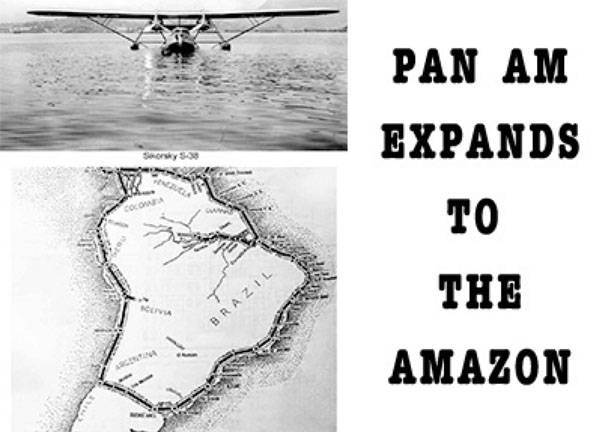
Size comparison: Top: Historic photo of cargo being loaded on Panagra Ford Tri-motor (Bill Larkins Collection, Wikimedia Commons). Bottom: AI photo of the Andes Mountains.
Pan American-Grace Airways (PANAGRA) Andean Division Manager, John “Johnny” Shannon, read a cable from New York City signed by President J.T. Trippe ordering a flight, Sunday January 14, 1934, along the Eastern Andes following a freak glacier-calving event three days before.
Johnny threaded a Ford 5-AT through the Upsallata Pass to Mendoza, Argentina, picked up the region’s Governor, and surveyed damage along the Tupungato and Mendoza Rivers.
According to New York Times reports, “The station master at Amarillo reported that an avalanche of ice and snow from the glacier dropped into the river at 7 o’clock Thursday evening [Jan. 11, 1934] holding back the river, which was greatly swollen as a result of a day’s heavy rain and the rapid melting of snow during the recent heat wave.” Then, seven hours later, the ice dam broke and “a high wall of water, sweeping along at twelve miles an hour, poured into the Mendoza River, carrying everything before it.”
Johnny reported every bridge on the Transandine Railway gone, swept a half-mile or more downstream by the flood, and railroad beds and roadways washed away. Given construction realities in such remote and rugged conditions, initial estimates suggested that neither rail nor road traffic would return for at least twelve months.
As such, both governments asked PANAGRA to carry all regional domestic mail, in addition to its international airmail allowances, and to increase its freight and passenger capacity for the foreseeable future. So the company shifted its two-day-per-week schedule to daily service, often flying three to four flights to meet demand. This service provided unexpected profits at a time when many Pan Am routes in South America lost money, and the transAndean route never returned to its earlier schedule.
Sources:
“Air Liners Carry All Mail Over Argentine-Chile Mountains.” Pan American Air Ways, Vol. 5, No. 1 (Jan. 1934), p. 2.
Banning, Gene. Airlines of Pan American Since 1927, Paladwyr Press, 2001, pp. 193-4.
White, John. W. “Argentine Flood is Laid to Ice Jam,” The New York Times, Jan. 14, 1934, p. 6.
FEBRUARY 1934
“One of a Kind:
Pan Am Dodges the Domestic Air Mail Scandal of 1934”
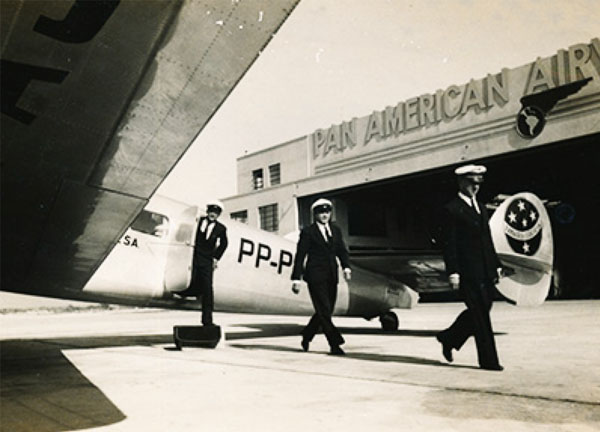
Photos: A study in environmental contrasts. Wintertime air mail operations by US Army Air Corps vs. Pan American’s international partnership in Brazil. Top: US Army Air Corps Keystone B-6 fueling during snowstorm, 1934 (Wikimedia). Bottom: Panair do Brasil crew exits Lockheed Lodestar, Rio c. 1934 (PAHF collection).
On February 9, 1934, President Roosevelt canceled US domestic air mail contracts. Within ten days, the US Army Air Corps would be carrying air mail in the US. That decision proved a deadly blunder, while Pan Am would continue to fly US foreign air mail.
The affair started months earlier when reporter Fulton Lewis learned that the Post Office Department had granted a contract to carry air mail for 69 cents/pound, while rejecting a far lower bid! Lewis thought something smelled rotten. He did some sleuthing and turned his information over to US Senator Hugo Black of Alabama.
Senate hearings followed, resulting in a ballooning scandal. It turned out that in 1930, the previous Hoover Administration's Postmaster General Walter Brown secretly colluded with a select group of airlines to favor them with air mail contracts, while freezing out other airlines. His intent was to make the system more efficient, but it plainly contravened the then-new Air Mail Act of 1930. The process was dubbed the "spoils conferences." These revelations soon found their way into President Roosevelt’s cabinet meeting. At the bad advice of Secretary of War George Dern, FDR ordered all current domestic air mail contracts canceled, and tasked the Army to fly domestic air mail.
Pan American Airways had also been favored by the prior Republican Administrations, but under a different law, the Foreign Air Mail Act of 1928. Under the act, Pan Am did not have to be the lowest bidder, just the one judged “best” by the Post Office. In truth, it was not a competitive bidding process. The arrangement was noticed by Senator Black and his committee.
But Pan Am mostly escaped FDR's wrath. There was no replacing America's sole international air carrier, no matter how great the political urge. Even after the intense public scrutiny of air mail contracts, Pan Am got off with a token and temporary revision of its air mail contract subsidy.
Air Corps fliers flew air mail in the US, and their orders proved fatal for thirteen of the ill-equipped and unprepared pilots. But it was impossible to have the US Army carry out the same all-important mission across foreign borders. Pan Am was the only US airline that operated outside the the US. Not only that, Pan Am's personnel, both in the air and on the ground successfully operated and maintained routes across far-flung mountains, jungles, deserts, and significant open water. All this required specialized knowledge, significant infrastructure, and operational experience, not to mention the willing cooperation of foreign governments. The US national interest trumped any political considerations.
Pan Am may have had a "special relationship" with Washington during the Republican years of the '20s and '30s, but even after that it was clear that the airline's importance to the US went far beyond politics, at least in 1934. Pan Am was truly one of a kind!
MARCH 1934
1. “New Bird Lifts Off”
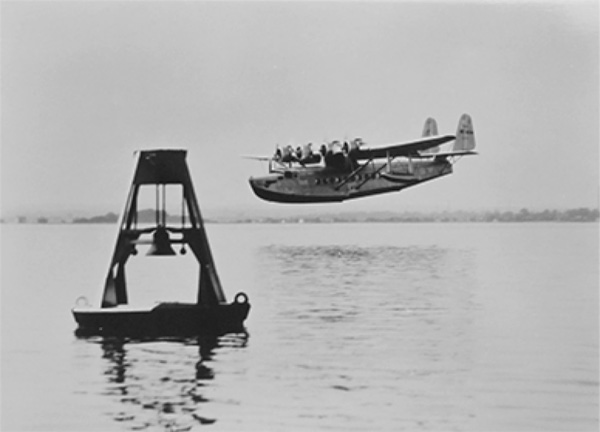
Photo: Sikorsky S-42 powered by Hornet Engines (PAHF collection).
It’s a specific world where six-hundred seconds of flight constitutes “success” (the Wright brother’s first 1903 flight 31 lasted 12 seconds) but on Thursday morning, March 29, 1934, Sikorsky Aircraft Corporation’s chief test pilot, Boris Sergievsky, and two mechanics, powered up the company’s newest aircraft, the Sikorsky S-42, and lifted off of Long Island Sound abreast the company’s Bridgeport, Connecticut base for a first-flight of an over-the-technological-edge seaplane designed to meet the companies’ most-important customer, Pan American Airways, Inc.’s demands.
Following an eight-second lift off, Sergievsky kept the untested four-engine aircraft aloft for ten minutes: aboard, these ten minutes probably seemed an eternity as he and two flight mechanics asked, “Will this $242,000 (approximately $5,500,000 in 2024) thing fly?”
With their first life-or-death fears removed, the three-person crew returned to the air for another ten-minute flight, then taxied the S-42 returned to the Sikorsky shop for a complete tear-down and assessment before required maneuverability and stability test flights on the next calm-water, low-wind, no-ice day.
That opportunity arrived the next week and this time the S-42 carried seven persons, including its designer Igor Sikorsky and H.A. Franchement, Pan American Airways Aircraft Engineer.
Through the aircraft’s month-long test period (an unfathomably short test window today) the initial S-42 set multiple world altitude, distance, and load records, due, in part, to its many technological innovations: “large wing flaps…flush riveting, engine synchronization, propeller brakes, and automatic carburetors.”
Sikorsky delivered the first S-42 aircraft, christened “Brazilian Clipper,” to Pan American Airways on May 6, 1934 and it remained in the company’s inventory for 12 years, outlasting all of its nine sister ships.
Sources:
Davies. R.E.G., “Pan Am: An Airline and its Aircraft,” Orion Books, 1987, p. 37.
“Giant Clipper Makes First Test Flight,” Pan American Air Ways, Vol. 5, No. 2 (March 1934), p. 1.
2. “First Lady Flies South”
 Photo: First Lady Eleanor Roosevelt ready to embark Pan American Airways' clipper to visit Puerto Rico, 1934-03-06 by Gleason Romer from Helen Muir Florida Collection. Special Collections and Archives. Miami-Dade Public Library System. https://cdm17273.contentdm.oclc.org/digital/collection/p17273coll3/id/15428/rec/17
Photo: First Lady Eleanor Roosevelt ready to embark Pan American Airways' clipper to visit Puerto Rico, 1934-03-06 by Gleason Romer from Helen Muir Florida Collection. Special Collections and Archives. Miami-Dade Public Library System. https://cdm17273.contentdm.oclc.org/digital/collection/p17273coll3/id/15428/rec/17
Early Tuesday, March 6, 1934, Miami’s newspaper reporter and photographer corps trailed passengers exiting the New York/Washington-Miami overnight train, focused on a group walking toward the “Aerocar,” heading to Pan American Airways’ Dinner Key base. There, as Eleanor Roosevelt boarded the 8:00 a.m. outbound Sikorsky S-40 “Clipper” and turned to allow the assembled photographers to take a picture of her holding a large bouquet of local flowers, she became the first First Lady of the United States to fly internationally.
Taking off, she began a twelve-day trip of Cuba and Uncle Sam’s possessions in the West Indies ( Puerto Rico, St. Thomas, St. Croix), touted as “a first-hand investigation of living and working conditions” in that region.
Pan Am personnel flew Eleanor along its regularly scheduled service to San Juan that Tuesday, stopping at Nuevitas, Cuba, to refuel and staying overnight in Port au Prince, Haiti. Then she flew on to San Juan, Puerto Rico, and boarded a chartered Pan Am Consolidated Commodore seaplane to continue on to a two-day visit to St. Thomas and St. Croix.
By noon at the end of her tour March 17th, a crowd had assembled to greet the First Lady on Sikorsky S-40, “Caribbean Clipper,” under the command of Pan Am veteran pilot Carl Dewey, as he landed the 38-seat craft at Dinner Key.
Once at the dock, the First Lady exited the aircraft, took questions from reporters, posed for pictures, signed autographs, then exited to catch her train back to Washington where she and her team would brief President Roosevelt on their inspection-tour findings.
Source: “First Lady of United States Uses Airline,” Pan American Air Ways, Vol. 5, No. 2 (March 1934), p. 1.
APRIL 1934
“Meal with a View”
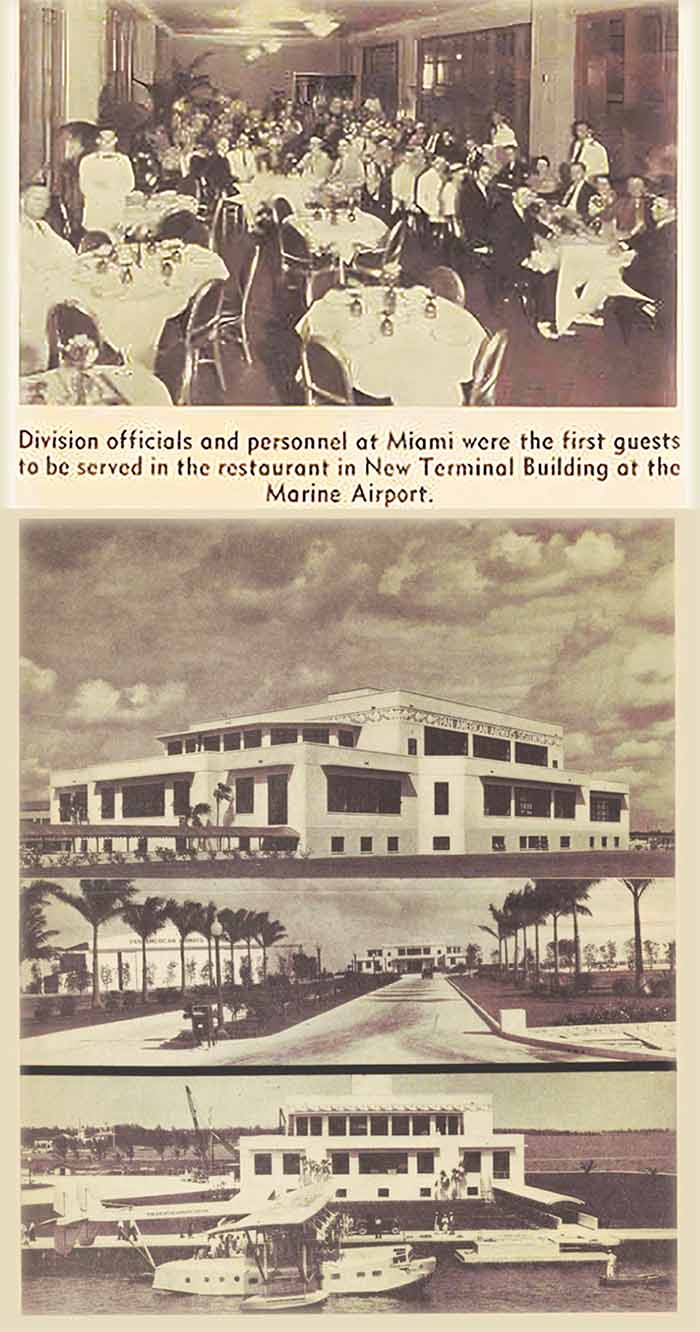
Photo compilation: From University of Miami, Special Collections, Pan American Air Ways, Vol. 5, No. 2, pp. 6 and 16.
https://digitalcollections.library.miami.edu/digital/collection/asm0341/id/50297/rec/9
With the last table cleared, skillet washed, and the lights out, Executive Chef Buehler reviewed his establishment’s Sunday April 1, 1934 grand opening. Across the evening his team plated 97 meals for guests who, seated in glass-heavy space atop the new Pan American Airways’ Dinner Key terminal were distracted from their carefully crafted entrees by stunning views of Biscayne Bay, well-heeled and well-known fellow diners, and photographer’s flashbulbs.
Three weeks earlier Buehler’s culinary team had faced even more-demanding diners, however — Pan Am’s Dinner Key base employees — when when the doors to the terminal’s bottom-floor company cafeteria opened Monday, March 12, 1934, reported as the “first actual use of the new building.”
After proving to the company’s blue-collar employees that the food and service met their standards, Chef Buehler staged a “soft-opening” banquet in the second-floor dining room for a cadre of Pan Am Caribbean Division officials and their guests.
The Pan American restaurant became Miami’s hottest dining spot, averaging 100-150 guests per night over the restaurant’s first month. With positive word-of-mouth and 35,000 visitors touring the airbase each month Buehler didn’t fear any imminent closure.
For the next decade food service at Dinner Key was an important part of the airbase’s place in aviation history and served clientele as diverse as found in New York City’s finest restaurants. On any given night locals sat amidst international celebrities, European royalty, South American diplomats and North American industrialists.
One night in the first week, Chef Buehler welcomed a particularly eclectic group, “a party that included a prince, two princesses, a baroness, a general, a commodore and a well-known author.”
Sources:
“Caribbean Division,” Pan American Air Ways, Vol. 5, No. 2 (March 1934), p. 11.
“Drive is Made for Visitors to Miami Base,” Pan American Air Ways, Vol. 5, No. 2 (March 1934), p. 5.
“New P.A.A. Restaurant Wins Wide Popularity,” Pan American Air Ways, Vol.5, No. 3 (April 1934), p. 10.
MAY 1934
“1934: Pan Am Expands Perspectives in Brazil”

Photo compilation: Sikorsky S-38 (PAHF Collection).
Map showing new Pan Am Belem to Manaus route in Brazil 1934, from the Official Aviation Guide of the Airways, August 1935.
Ninety years ago, Brazil’s interior was notably difficult to access by boat, taking two weeks or more to travel from Belem on the coast, to the Amazon River city of Manaus. But by air, it was slowly opening up to the outside world. It was in late summer 1933 that Pan Am made survey flights up the Amazon River to Manaus, finally setting up operations and a station there.
Shortly after, PAA affiliate Panair do Brasil inaugurated weekly passenger service on a new route with Sikorsky S-38 amphibians taking passengers to Amazon River destinations in less than 12 hours. That same year, Charles and Anne Morrow Lindbergh explored the Amazon in their tiny Lockheed Sirius during the flight home from their epic Arctic and African surveys.
The tremendous media coverage during the Lindberghs' famous flight sparked public interest in traveling to exotic South American locations. And by May 1934, Pan Am’s affiliate Panair do Brasil began using larger flying boats in their fleet -- Consolidated Commodores -- to transport even more passengers and cargo to the Amazon jungle.
That month, as interest in Brazil's interior regions grew, Hollywood Director George B. Seitz, with Harold Noice, explorer and author, collaborated on a location-scouting trip for a proposed MGM film. They flew from Belem to Manaus, and went further upriver on a chartered Pan Am Sikorsky S-38 to explore jungle streams. The film never happened, but Harold Noice later produced a radio series “The Black Flame of the Amazon” (1938), and authored a book about his explorations in the Amazon, “Back to Beyond” (1939).
Sources:
"Pan American Air Ways", Vol. 5., No. 4 (May-June 1934), from the PAHF Collection.
R.E.G. Davies. "Airlines of Pan American Since 1927" (Paladwr Press, 2001), p. 248.
JUNE 1934
“1934: The Last Word in Travel Comfort"
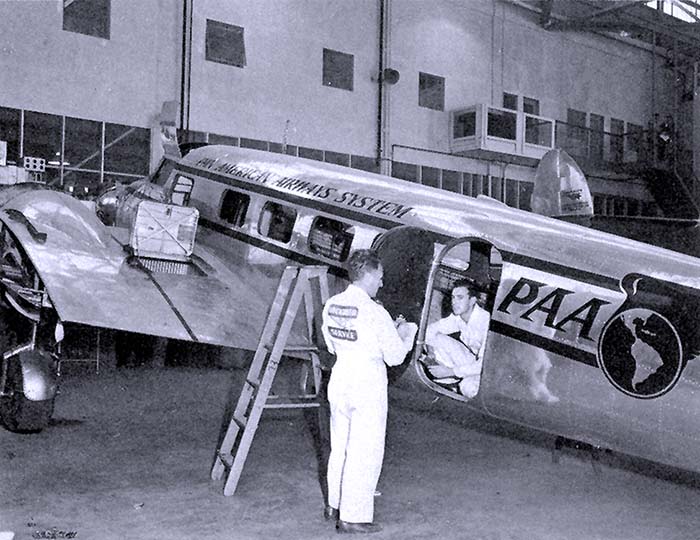
Photo: Maintenance on Pan Am Lockheed Electra (PAHF collection).
New Electra Features
"LOS ANGELES. — Deeply upholstered reclining-type chairs, individually operated ventilators over each seat, reading lights, co-pilot call buttons, ashtrays, a lavatory and thorough soundproofing provide the last word in travel comfort for passengers in the newest high-speed transport airplane, the 221-mile-an-hour Lockheed Electra which is nearing completion for Pan American Airways System.
Although the Electra has a small frontal area due to sinking the fuselage into the wing, it has a 58½-inch wide cabin which provides ample space for comfortable seating of 10 passengers in arm chairs. Generous leg room is provided between the chairs. The height of the cabin is 60 inches.
To provide what is perhaps the quietest cabin of any high-speed transport plane in the world, Western Electric engineers were employed to soundproof the Electra. The cabin is completely lined with three layers of ⅛-inch kapok sheets. The center sheet is krinkled so as to leave an air space between the outer layer which is glued to the metal shell of the fuselage and the inner layer over which the upholstering cloth is laid. At 200 m.p.h. the noise intensity in parts of the cabin is as low as 70 decibels, which corresponds to that of a Pullman car.
The walls and ceiling are finished with a light olive green upholstering cloth, while the seats are covered with a material of slightly darker shade, producing a harmonious and restful two-tone effect.”
Source:
"Pan American Air Ways," Vol. 5, No. 4 (June-July 1934) p. 16.
JULY 1934
“1934: Summer Successes"

Pan American Airways poster by Kenneth Thompson, NASM.
https://airandspace.si.edu/collection-media/NASM-7338E8F574A92_001
July 1934 proved to be a great inflection point, marking future successes for Pan American Airways in terms of its investor confidence, as well as expanding its business opportunities.
A Pan Am milestone
The Board of directors of Pan Am authorized a dividend of 25 cents a share, payable August 1, 1934. This marked the very first distribution to stockholders by the company since the founding of Pan Am seven years earlier in 1927.
New Contract
Also in the month of July '34 Pan American and the Railway Express Agency signed a contract to form new international shipping services. By August, Pan Am began to offer door-to-door delivery service to the Caribbean, Mexico, Central America and South America with the cooperation of the Railway Express Agency air division from points all over the U.S.
On August 5, 1934, Reginald Cleveland of The New York Times reported:
"More than a ton of merchandise of many kinds, shipped from about 50 cities in the United States, will be delivered to every country south of the Rio Grande on the first flight next Tuesday of air express under the new simple waybill arrangement worked out by Pan American Airways and the air division of the Railway Express Agency. Packages that leave the Pacific Coast tomorrow morning over the routes of United Air Lines will be in flight over the Caribbean [via Pan Am] on Wednesday and be delivered in Brazil or Peru three days later."
By November 1934, the system was working so smoothly that a pair of porcupines were successfully shipped from the mouth of the Amazon River in Brazil. Arriving after a seven-day, 4500 mile trip from Manaus, they were delivered to the customs division of the Railway Express Agency on 10th Avenue in New York, for a collector of "zoological novelties."
Sources:
Althea "Gerry" Lister notes (July 1934) .
"Amazon Porcupines Last Word in Pets," The New York Times, November 14, 1934, p. 23.
"Contact" by Reginald Cleveland, The New York Times, August 5, 1934, p. XX9.
AUGUST 1934
"The Most Modern Aircraft"
Compilation: “New Clipper In Record Run to South American” (Front page, Pan American Air Ways, July-August 1934 ), Douglas DC-2 over the Andes (left) and Douglas Dolphin over Shanghai (PAHF Collection).
August 1934 was a busy month for Pan American Airways, adding new, state-of-the-art aircraft to their fleet and to the operations of their affiliates.
On the 10th, the company ordered two Douglas Dolphin seaplanes for flights on the coast and rivers of China. The aircraft were quickly delivered to Pan Am by the 30th of the month, and sent to China National Aviation Corporation.
That same month, the most modern airliner to date was added to operations — Pan Am’s very first Douglas DC-2. This plane could carry 14 passengers with more speed and in more comfort than had ever existed before in any airplane.
The DC-2 was so popular and the demand so great, that Douglas became the first manufacturer to adopt mass production techniques at its Santa Monica, California facility.
Pan Am DC-2s flew for Panagra, and Mexicana in the Western Hemisphere, and served for many years to help CNAC defenses in China. In total, Pan Am acquired 27 DC-2s, including four military C-39s purchased after World War Two.
On August 22, 1934, with great fanfare, the Brazilian Clipper, Pan Am’s very first Sikorsky S-42 (NC822M) was formally christened in Rio by Mrs. Getúlio Vargas, wife of the President of Brazil. The S-42 clipper set new world records and shaved off two days of travel on the New York - Buenos Aires run. It was called “an airliner before its time” by historian R.E.G. Davies.
Sources:
“Pan American Air Ways,” Vol. 5, No. 5, July-August 1934 (PAHF collection & UM Special Collections).
“Pan Am An Airline and Its Aircraft.” R.E. G. Davies, Orion, 1987.
SEPTEMBER 1934
"Crosson to Russia"

Photo Joe Crosson and Pacific Alaska Fairchild 71 (SDASM Archives, https://www.flickr.com/photos/sdasmarchives/8068574121/in/album-72157631732765977/
When Pan Am’s B-707 Clipper Stargazer, landed in Moscow on July 15, 1968, most people were likely to remark on what they thought was the first time an American airline had operated a flight to what was then the Soviet Union.
It was understandable - but wrong. Pan Am’s first official USSR flight had come decades earlier.
On September 3, 1934, a single-engine Fairchild F-71, owned by Pan Am subsidiary Pacific Alaska Airways and piloted by legendary Alaskan aviator Joe Crosson, had crossed the waters dividing the US and Siberia with several official passengers and a bit of mail. The mission involved exploring the potential for a hoped-for air bridge between the two countries, and the practical beginnings of a direct westward route from the New World to Asia.
When the hardy little Fairchild left Nome, Alaska bound for Anadyr, Siberia it carried Assistant US Postmaster General Harlee Branch; Robert Thatch, senior Pan Am executive from New York; Lyman Peck, Pacific Alaska Airways Manager; and radio operator Bob Gleason.
At the time, the flight barely received public notice. As an aviation milestone, it didn’t rate much attention. The 180-mile flight took under two hours. But in terms of international significance, it rated as something significant.
1934 was the year that the United States was finally coming around to recognizing that the Soviet Union was a fact of life. For years, since the end of the bitter and violent civil war that followed the Russian Revolution, the US had refused to officially recognize the USSR. In 1934,the two nations were finally going to exchange ambassadors.
For American aviation, and Pan American in particular, the opening of relations with the Soviets meant that there could be a reasonable chance to establish a Great Circle route to Asia. The air route from Alaska to Siberia, and thence southward, could lead to a air connection with China, where Pan Am had already established a foothold with the acquisition of Curtiss-Wright’s minority stake in the China National Aviation Corporation (CNAC) the previous year. And two years before that, Pan Am had subsidized the pioneering survey flight by Charles and Anne Lindbergh, who explored the aerial path to China via Alaska and Japan.
The significance of Crosson’s mission was not lost on those who saw the big picture. Lauren Lyman, Aviation reporter for the New York Times commented in an article published the following week:
”Such a [Great Circle route] service would link up North America, Asia and Europe with a continuous air line without a single broken link more than five-sixths of the way around the northern half of the earth. It would extend the present far-flung air routes of Pan American from Buenos Aires to Siberia, save for the lines connecting within the United States and Canada.”
Sources:
Photo: Pan Am Clipper #7, a Martin M-130, being built at Middle River, MD: Pan American Air Ways, September-October 1934 (PAHF Collection).
The headline said it all; "Flying Clipper Ship Number 7, The World's Mightiest Airliner to Conquer the Oceans is Appearing at Baltimore."
The September-October 1934 Pan American Air Ways issue provided a lavish spread to herald the news that Clipper #7 was about to emerge at the Glenn L. Martin factory in Baltimore. The brand new Martin M-130, later famously known as the “Hawaii Clipper," was the first of three pioneering flying boats developed by Martin for Pan Am. These aircraft would be instrumental in establishing long-distance international air travel. The M-130 could carry up to 46 passengers and featured innovative design elements like fuselage-mounted sponsons. It was the first aircraft to feature Pratt & Whitney Twin-Wasp engines.
As described in Pan American Air Ways, the new aircraft was indeed a big step in the evolution of commercial aviation:
In the great aircraft plant of the Glenn L. Martin Company is rapidly emerging the largest and most advanced aerial transport that the world has ever known, designed to master the great oceans which for 400 years have been unconquerable barriers between the hemispheres.
Into the making of this giant Pan American Clipper Ship have gone years of research in physical and chemical laboratories, of endless hours of tedious engineering designs, of slow and careful toil within the shops.
Pan Am's publicists had every reason to use hyperbole in describing the giant aircraft. After many months of work under wraps following their successful bid to Pan Am to build an advanced new flying boat, the new Martin plane looked very impressive.
The M-130 could carry a useful load of over 22,000 lbs., almost equal to its own weight. It had a range of 3,000 miles. The new Clipper was faster and larger than the Sikorsky S-42, also recently introduced, and would fit the bill for Pan Am's need for a truly transpacific aircraft, even better than the S-42.
Although Clipper #7 was the first M-130 built, it would remain at the factory while the Martin Company tweaked the design. The first M-130 delivered to Pan Am would be NC-14716, the famous "China Clipper." The second M-130 delivered was the "Philippine Clipper," NC-14715. Clipper #7 would bear registration NC-14714. Pan Am had begun numbering four-engined flying boats with the Clipper name with the first Sikorsky S-40, "American Clipper" in 1931, and sequentially numbering subsequent Clippers prior to their official christening by the airline. Thus the first M-130, following on after three S-40s, and the first three S-42s, was "Clipper #7."
In November 1934, during testing, Clipper #7 took off on Chesapeake Bay in an amazing 11 minutes. Far into the future, every Pan Am aircraft would be known as a Clipper. It was a proud heritage.
Althea "Gerry" Lister notes (November 1934).
Robert Gandt, "China Clipper" (Naval Institute Press), 1991.
“Pan American Air Ways,” Vol. 5, No. 6, September-October 1934 (PAHF collection).

